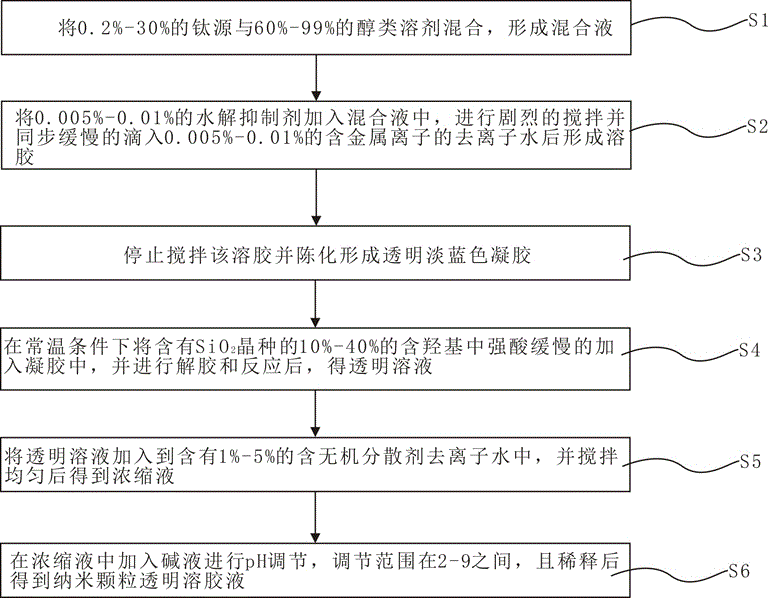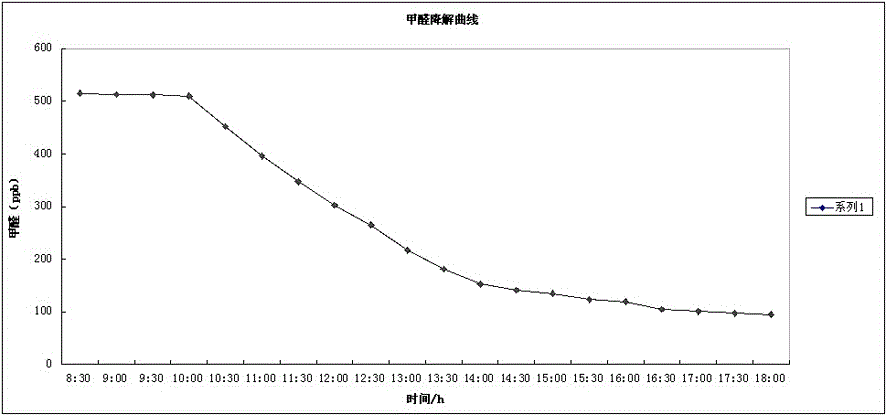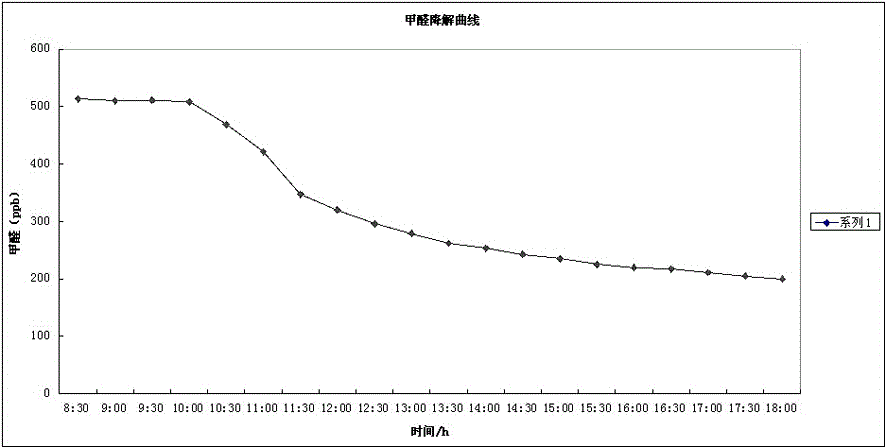Nano-spherical porous low-light photocatalyst for degrading formaldehyde, preparation method and application thereof
A low-light, spherical technology, applied in the field of photocatalyst, can solve the problems of complex load forming process, difficulty in industrialization, easy pulverization and falling off, etc., to improve the utilization rate of natural visible light, get rid of the restrictions of use occasions, and improve film adhesion Good results
- Summary
- Abstract
- Description
- Claims
- Application Information
AI Technical Summary
Problems solved by technology
Method used
Image
Examples
preparation example Construction
[0049] see figure 1 , the preparation method of the nano-spherical porous weak light photocatalyst that is used to degrade formaldehyde provided by the invention, comprises the following steps:
[0050] Step S1, mixing 0.2%-30% titanium source with 60%-99% alcohol solvent to form a mixed solution; in this step, the titanium source is n-butyl titanate, titanium tetrachloride, titanium trichloride, Any one of titanyl sulfate or ethyl titanate, the number of carbons in the alcohol solvent is 1-4, and it is absolute ethanol, n-propanol, isopropanol, n-butanol, sec-butanol or isobutanol any of the alcohols.
[0051] Step S2, adding 0.005%-0.01% hydrolysis inhibitor into the mixed solution, stirring vigorously and synchronously slowly dropping 0.005%-0.01% deionized water containing metal ions to form a sol; in this step, the hydrolysis inhibitor The agent is any one of glacial ester, acetylacetone, concentrated hydrochloric acid, and concentrated nitric acid, and the metal ion in...
experiment example 1
[0066] 1. Experimental method:
[0067] 1. Spray a certain amount of 0.5% nanoparticle transparent sol solution sample on a 1 square meter glass plate, place it in a 1.5 cubic meter glass experimental chamber, and fill it with a certain amount of standard concentration of formaldehyde gas under darkroom conditions , and start the air circulation pump in the warehouse, and stop filling the formaldehyde standard gas when the formaldehyde concentration in the warehouse is stable at 510ppb. After the dark adsorption equilibrium (the process time is generally 0.5-1h, when the gas concentration in the chamber changes less than 10ppb / h, it is regarded as the dark adsorption equilibrium), the internal formaldehyde concentration is measured three times within the next 1.5h, and recorded. After the test, turn on the fluorescent lamp (wavelength range 400-800nm) in the warehouse for irradiation. Record the formaldehyde concentration in the box every half hour.
[0068] 2. Experimental ...
experiment example 2
[0075] 1. Experimental method:
[0076] 1. Spray a certain amount of 0.2% nanoparticle transparent sol solution sample on a 1 square meter glass plate, place it in a 1.5 cubic meter glass experimental chamber, and fill it with a certain amount of standard concentration of formaldehyde gas under darkroom conditions , and start the air circulation pump in the warehouse, and stop filling the formaldehyde standard gas when the formaldehyde concentration in the warehouse is stable at 510ppb. After the dark adsorption equilibrium (the process time is generally 0.5-1h, when the gas concentration in the chamber changes less than 10ppb / h, it is regarded as the dark adsorption equilibrium), the internal formaldehyde concentration is measured three times within the next 1.5h, and recorded. After the test, turn on the fluorescent lamp (wavelength range 400-800nm) in the warehouse for irradiation. Record the formaldehyde concentration in the box every half hour.
[0077] 2. Experimental ...
PUM
| Property | Measurement | Unit |
|---|---|---|
| particle diameter | aaaaa | aaaaa |
| specific surface area | aaaaa | aaaaa |
Abstract
Description
Claims
Application Information
 Login to View More
Login to View More - R&D
- Intellectual Property
- Life Sciences
- Materials
- Tech Scout
- Unparalleled Data Quality
- Higher Quality Content
- 60% Fewer Hallucinations
Browse by: Latest US Patents, China's latest patents, Technical Efficacy Thesaurus, Application Domain, Technology Topic, Popular Technical Reports.
© 2025 PatSnap. All rights reserved.Legal|Privacy policy|Modern Slavery Act Transparency Statement|Sitemap|About US| Contact US: help@patsnap.com



